1990 VOLKSWAGEN CORRADO sensor
[x] Cancel search: sensorPage 428 of 906

B - EMISSION APPLICATION
Article Text (p. 2)
1990 Volkswagen Corrado
For Volkswagen Technical Site: http://vw.belcom.ru
Copyright © 1998 Mitchell Repair Information Company, LLC
Thursday, March 23, 2000 09:43PM
EVAP-PVB - EVAP Purge Valve
EVAP-SV - EVAP Solenoid Valve
EVAP-VC - EVAP Vacuum Canister
EVAP-VS - EVAP Vacuum Sensor
O2 - Oxygen Sensor
OC - Oxidation Catalyst
PAS - Pulse Air Injection System
PCV - Positive Crankcase Ventilation
PCV-HCB - PCV Heated Crankcase Breather
PFI - Programmed Fuel Injection
SPK - Spark Timing Control
SPK-CC - Spark Computer Controlled
TAC - Thermostatic Air Cleaner
TWC - Three-Way Catalyst
VA - Vacuum Amplifier
VR - Vacuum Retard
VS - Vacuum Sensor
END OF ARTICLE
Page 433 of 906
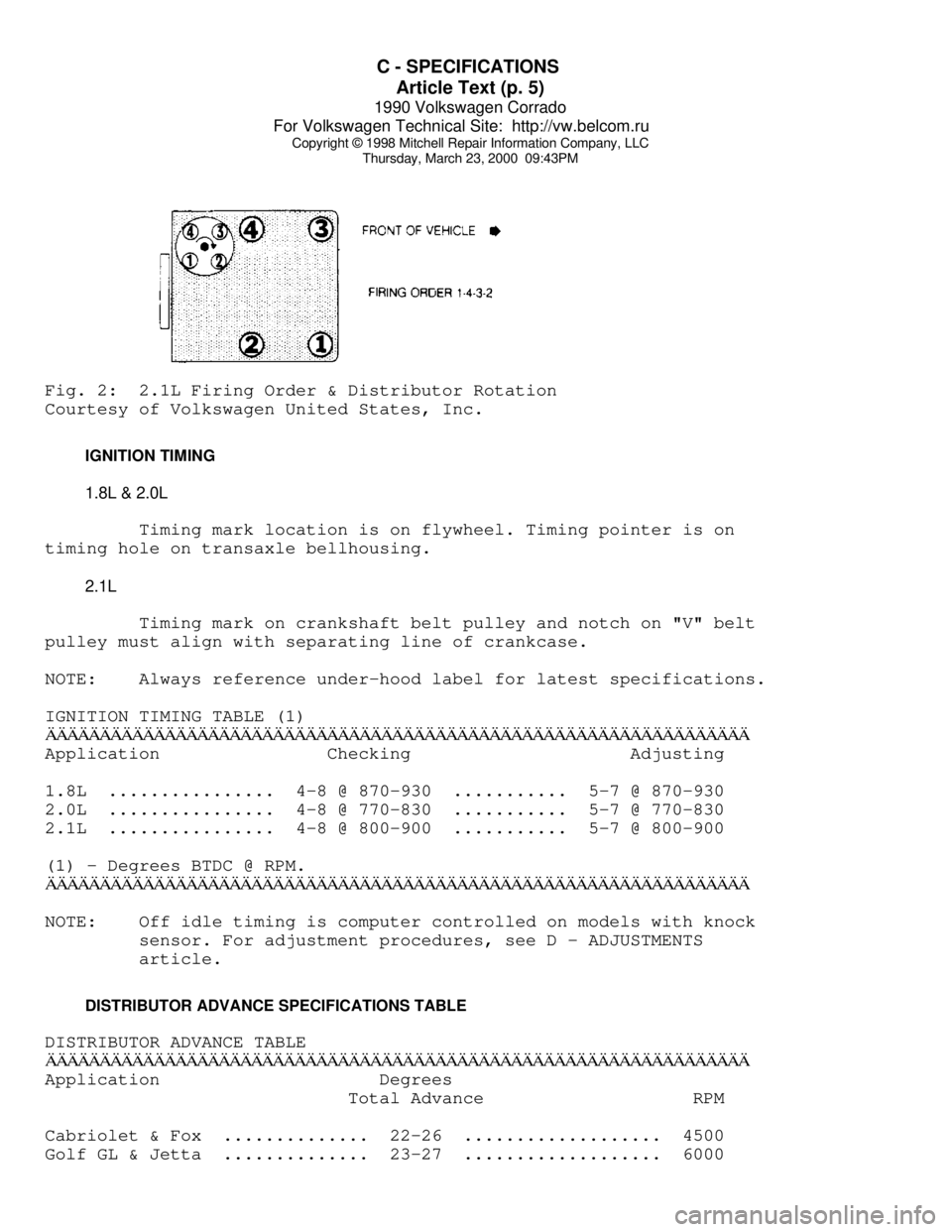
C - SPECIFICATIONS
Article Text (p. 5)
1990 Volkswagen Corrado
For Volkswagen Technical Site: http://vw.belcom.ru
Copyright © 1998 Mitchell Repair Information Company, LLC
Thursday, March 23, 2000 09:43PMFig. 2: 2.1L Firing Order & Distributor Rotation
Courtesy of Volkswagen United States, Inc.
IGNITION TIMING
1.8L & 2.0L
Timing mark location is on flywheel. Timing pointer is on
timing hole on transaxle bellhousing.
2.1L
Timing mark on crankshaft belt pulley and notch on "V" belt
pulley must align with separating line of crankcase.
NOTE: Always reference under-hood label for latest specifications.
IGNITION TIMING TABLE (1)ÄÄÄÄÄÄÄÄÄÄÄÄÄÄÄÄÄÄÄÄÄÄÄÄÄÄÄÄÄÄÄÄÄÄÄÄÄÄÄÄÄÄÄÄÄÄÄÄÄÄÄÄÄÄÄÄÄÄÄÄÄÄÄÄÄApplication Checking Adjusting
1.8L ................ 4-8 @ 870-930 ........... 5-7 @ 870-930
2.0L ................ 4-8 @ 770-830 ........... 5-7 @ 770-830
2.1L ................ 4-8 @ 800-900 ........... 5-7 @ 800-900
(1) - Degrees BTDC @ RPM.
ÄÄÄÄÄÄÄÄÄÄÄÄÄÄÄÄÄÄÄÄÄÄÄÄÄÄÄÄÄÄÄÄÄÄÄÄÄÄÄÄÄÄÄÄÄÄÄÄÄÄÄÄÄÄÄÄÄÄÄÄÄÄÄÄÄNOTE: Off idle timing is computer controlled on models with knock
sensor. For adjustment procedures, see D - ADJUSTMENTS
article.
DISTRIBUTOR ADVANCE SPECIFICATIONS TABLE
DISTRIBUTOR ADVANCE TABLE
ÄÄÄÄÄÄÄÄÄÄÄÄÄÄÄÄÄÄÄÄÄÄÄÄÄÄÄÄÄÄÄÄÄÄÄÄÄÄÄÄÄÄÄÄÄÄÄÄÄÄÄÄÄÄÄÄÄÄÄÄÄÄÄÄÄApplication Degrees
Total Advance RPM
Cabriolet & Fox .............. 22-26 ................... 4500
Golf GL & Jetta .............. 23-27 ................... 6000
Page 438 of 906

D - ADJUSTMENTS
Article Text
1990 Volkswagen Corrado
For Volkswagen Technical Site: http://vw.belcom.ru
Copyright © 1998 Mitchell Repair Information Company, LLC
Thursday, March 23, 2000 09:43PM
ARTICLE BEGINNING
1990 ENGINE PERFORMANCE
On-Vehicle Adjustments
Volkswagen; Cabriolet, Corrado, Fox, Golf GL/GTI,
Jetta, Vanagon
ENGINE COMPRESSION
Check engine compression with engine at normal operating
temperature at specified cranking speed, all spark plugs removed and
throttle wide open.
ENGINE COMPRESSION TESTÄÄÄÄÄÄÄÄÄÄÄÄÄÄÄÄÄÄÄÄÄÄÄÄÄÄÄÄÄÄÄÄÄÄÄÄÄÄÄÄÄÄÄÄÄÄÄÄÄÄÄÄÄÄÄÄÄÄÄÄÄÄÄÄÄÄÄÄÄÄModel Standard Minimum
psi (kg/cm
ý) psi (kg/cmý)
Cabriolet ............. 131-174 (9.0-12.0) ............. 109 (7.5)
Corrado ............... 116-174 (8.0-12.0) .............. 87 (6.0)
Fox ................... 131-174 (9.0-12.0) ............. 102 (7.0)
Golf GL/GTI 1.8L ...... 131-174 (9.0-12.0) ............. 102 (7.0)
Jetta ................. 131-174 (9.0-12.0) ............. 102 (7.0)
Jetta GLi 2.0L ........ 145-190 (10.0-13.0) ............ 109 (7.5)
Vanagon ............... 87-131 (6.1-9.2) ................ 87 (6.0)
ÄÄÄÄÄÄÄÄÄÄÄÄÄÄÄÄÄÄÄÄÄÄÄÄÄÄÄÄÄÄÄÄÄÄÄÄÄÄÄÄÄÄÄÄÄÄÄÄÄÄÄÄÄÄÄÄÄÄÄÄÄÄÄÄÄÄÄÄÄÄ VALVE CLEARANCE
NOTE: All models use hydraulic lifters. No adjustments are
required.
IGNITION TIMING
NOTE: Basic timing readings are only valid when engine idle speed
and idle mixture are within specifications. For best
results, the manufacturer recommends ignition timing, idle
CO and idle speed be checked and adjusted in that order.
NOTE: Off idle timing is computer controlled on models with knock
sensor(s). Only idle ignition timing can be set.
ALL MODELS EXCEPT VANAGON
1) Warm engine to normal operating temperature (cooling fan
should cycle at least once). Remove the 27 mm plastic plug from timing
check hole on transaxle bellhousing.
2) With ignition off, connect a tachometer and timing light
to vehicle. Start engine, raise speed above 2100 RPM a few times, and
allow engine to idle normally. With distributor vacuum hoses
Page 440 of 906
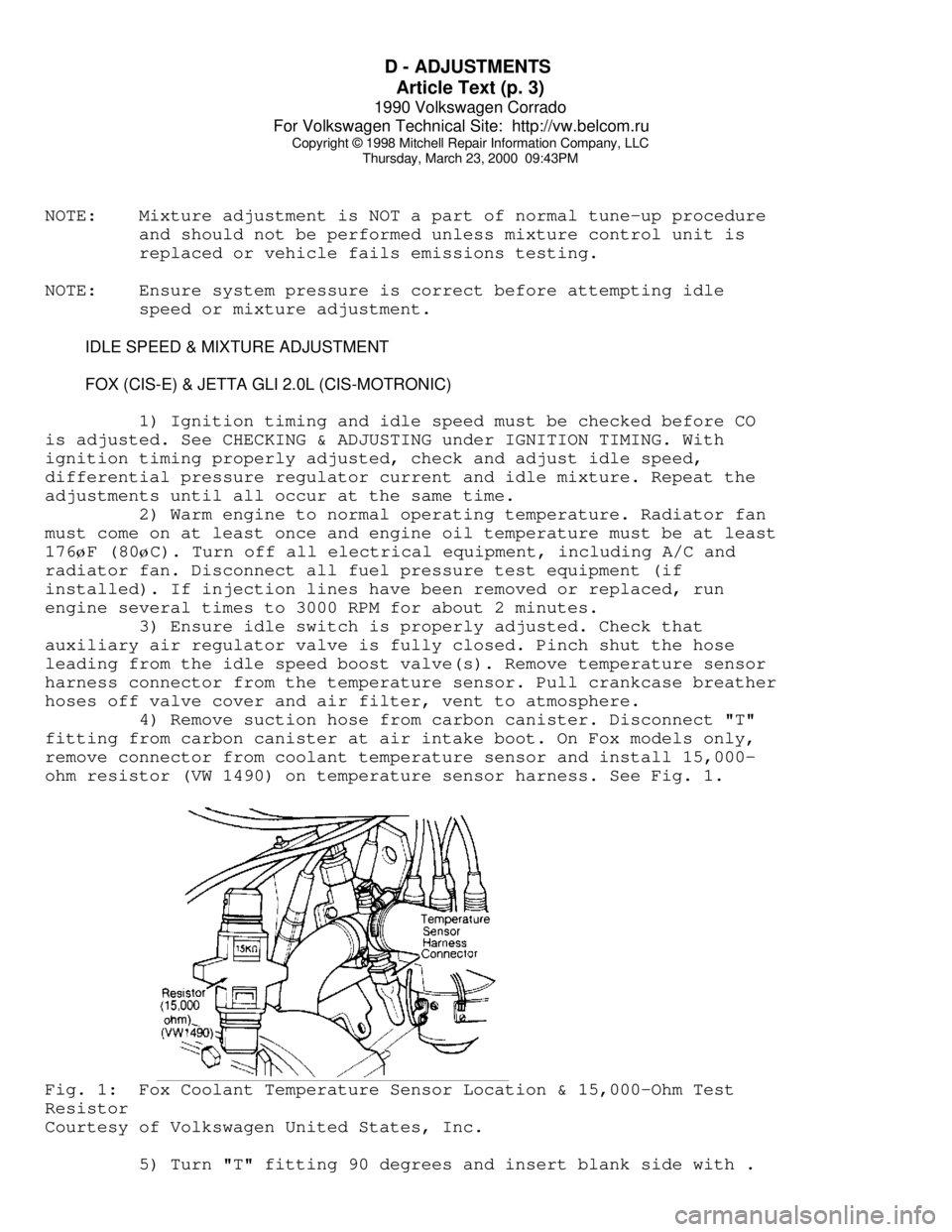
D - ADJUSTMENTS
Article Text (p. 3)
1990 Volkswagen Corrado
For Volkswagen Technical Site: http://vw.belcom.ru
Copyright © 1998 Mitchell Repair Information Company, LLC
Thursday, March 23, 2000 09:43PM
NOTE: Mixture adjustment is NOT a part of normal tune-up procedure
and should not be performed unless mixture control unit is
replaced or vehicle fails emissions testing.
NOTE: Ensure system pressure is correct before attempting idle
speed or mixture adjustment.
IDLE SPEED & MIXTURE ADJUSTMENT
FOX (CIS-E) & JETTA GLI 2.0L (CIS-MOTRONIC)
1) Ignition timing and idle speed must be checked before CO
is adjusted. See CHECKING & ADJUSTING under IGNITION TIMING. With
ignition timing properly adjusted, check and adjust idle speed,
differential pressure regulator current and idle mixture. Repeat the
adjustments until all occur at the same time.
2) Warm engine to normal operating temperature. Radiator fan
must come on at least once and engine oil temperature must be at least
176øF (80øC). Turn off all electrical equipment, including A/C and
radiator fan. Disconnect all fuel pressure test equipment (if
installed). If injection lines have been removed or replaced, run
engine several times to 3000 RPM for about 2 minutes.
3) Ensure idle switch is properly adjusted. Check that
auxiliary air regulator valve is fully closed. Pinch shut the hose
leading from the idle speed boost valve(s). Remove temperature sensor
harness connector from the temperature sensor. Pull crankcase breather
hoses off valve cover and air filter, vent to atmosphere.
4) Remove suction hose from carbon canister. Disconnect "T"
fitting from carbon canister at air intake boot. On Fox models only,
remove connector from coolant temperature sensor and install 15,000-
ohm resistor (VW 1490) on temperature sensor harness. See Fig. 1.Fig. 1: Fox Coolant Temperature Sensor Location & 15,000-Ohm Test
Resistor
Courtesy of Volkswagen United States, Inc.
5) Turn "T" fitting 90 degrees and insert blank side with .
Page 443 of 906
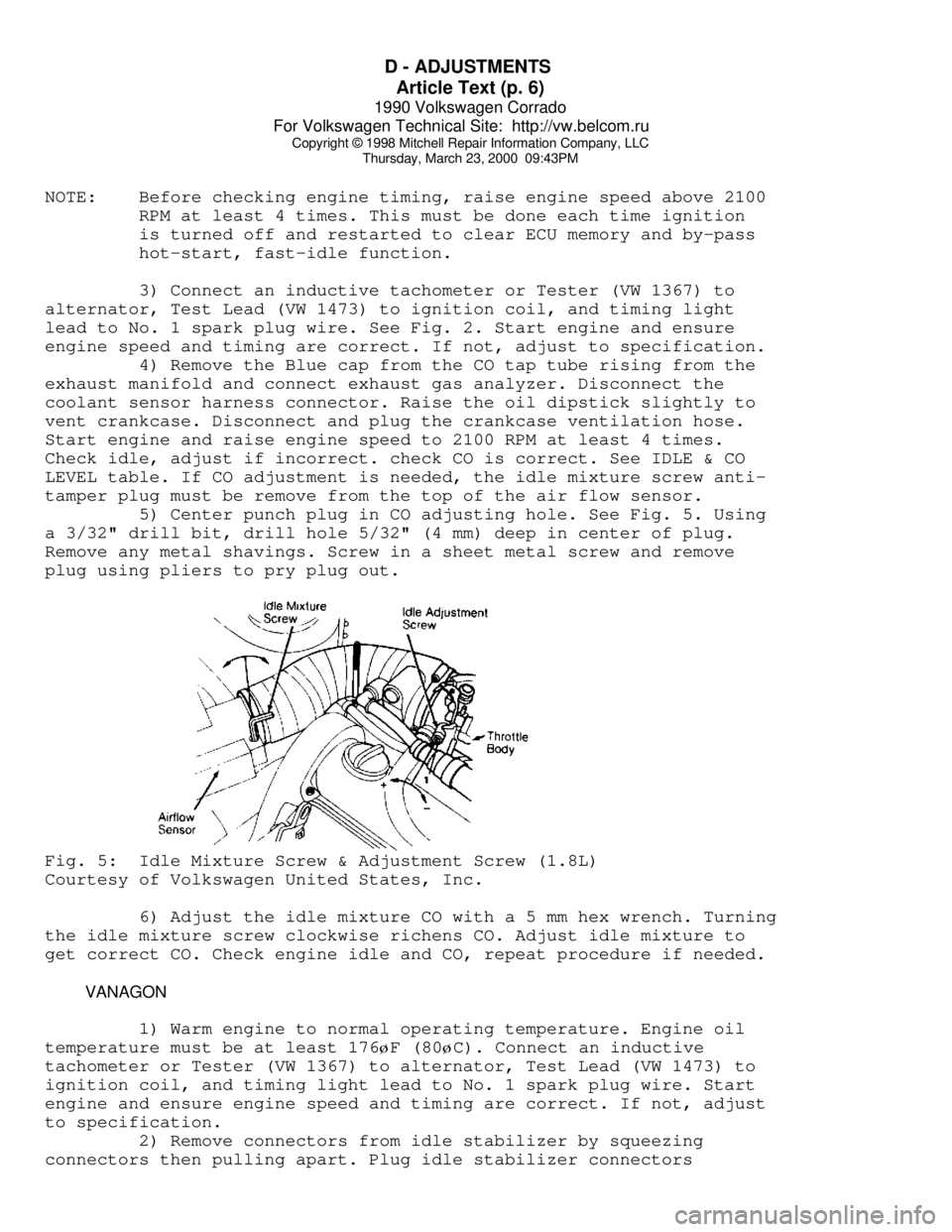
D - ADJUSTMENTS
Article Text (p. 6)
1990 Volkswagen Corrado
For Volkswagen Technical Site: http://vw.belcom.ru
Copyright © 1998 Mitchell Repair Information Company, LLC
Thursday, March 23, 2000 09:43PM
NOTE: Before checking engine timing, raise engine speed above 2100
RPM at least 4 times. This must be done each time ignition
is turned off and restarted to clear ECU memory and by-pass
hot-start, fast-idle function.
3) Connect an inductive tachometer or Tester (VW 1367) to
alternator, Test Lead (VW 1473) to ignition coil, and timing light
lead to No. 1 spark plug wire. See Fig. 2. Start engine and ensure
engine speed and timing are correct. If not, adjust to specification.
4) Remove the Blue cap from the CO tap tube rising from the
exhaust manifold and connect exhaust gas analyzer. Disconnect the
coolant sensor harness connector. Raise the oil dipstick slightly to
vent crankcase. Disconnect and plug the crankcase ventilation hose.
Start engine and raise engine speed to 2100 RPM at least 4 times.
Check idle, adjust if incorrect. check CO is correct. See IDLE & CO
LEVEL table. If CO adjustment is needed, the idle mixture screw anti-
tamper plug must be remove from the top of the air flow sensor.
5) Center punch plug in CO adjusting hole. See Fig. 5. Using
a 3/32" drill bit, drill hole 5/32" (4 mm) deep in center of plug.
Remove any metal shavings. Screw in a sheet metal screw and remove
plug using pliers to pry plug out.Fig. 5: Idle Mixture Screw & Adjustment Screw (1.8L)
Courtesy of Volkswagen United States, Inc.
6) Adjust the idle mixture CO with a 5 mm hex wrench. Turning
the idle mixture screw clockwise richens CO. Adjust idle mixture to
get correct CO. Check engine idle and CO, repeat procedure if needed.
VANAGON
1) Warm engine to normal operating temperature. Engine oil
temperature must be at least 176øF (80øC). Connect an inductive
tachometer or Tester (VW 1367) to alternator, Test Lead (VW 1473) to
ignition coil, and timing light lead to No. 1 spark plug wire. Start
engine and ensure engine speed and timing are correct. If not, adjust
to specification.
2) Remove connectors from idle stabilizer by squeezing
connectors then pulling apart. Plug idle stabilizer connectors
Page 444 of 906

D - ADJUSTMENTS
Article Text (p. 7)
1990 Volkswagen Corrado
For Volkswagen Technical Site: http://vw.belcom.ru
Copyright © 1998 Mitchell Repair Information Company, LLC
Thursday, March 23, 2000 09:43PM
together. Turn idle speed screw until idle speed is correct. To adjust
timing, see CHECKING & ADJUSTING under IGNITION TIMING in this
article.
3) Ensure all vehicle electrical equipment is off. Place
exhaust gas analyzer in exhaust pipe. See IDLE SPEED & CO LEVEL table.
If adjustment is needed, go to next step.
4) If adjustment is needed in step 2). Remove intake air
sensor from engine. Center punch plug in CO adjusting hole. Using a
3/32" drill bit, drill hole 5/32" (4 mm) deep in center of plug.
Remove any metal shavings. Screw in a sheet metal screw and remove
plug using pliers to pry plug out.
5) Disconnect oxygen sensor connector on left side of engine
compartment (Green wire). Start engine. Set idle speed and CO reading
by alternately turning mixture and idle speed adjustment screws.
Reconnect oxygen sensor and idle stabilizer connectors. Let engine
idle for 2 minutes.
6) Check CO value. If incorrect, repeat adjusting procedure.
If correct turn ignition off. Drive in new adjusting hole plug flush
with air intake sensor. Remove all test equipment and reconnect all
hoses and wiring.
NOTE: Do not push down on adjustment screw and do not accelerate
engine with wrench in plate. Remove wrench after each
adjustment and accelerate engine briefly before measuring
current reading. Always adjust from a high to a low reading.
IDLE SPEED & CO LEVELÄÄÄÄÄÄÄÄÄÄÄÄÄÄÄÄÄÄÄÄÄÄÄÄÄÄÄÄÄÄÄÄÄÄÄÄÄÄÄÄÄÄÄÄÄÄÄÄÄÄÄÄÄÄÄÄÄÄÄÄÄÄÄÄÄÄÄÄÄÄApplication Idle RPM CO Level
Cabriolet .................. 850-1000 ................... 0.3-1.2%
Fox ........................ 800-1000 ................... 0.3-1.2%
Golf ....................... 800-1000 ................... 0.3-1.2%
Golf GT ..................... 800-900 ................... 0.3-1.2%
GTI ........................ 800-1000 ................... 0.3-1.2%
Jetta ...................... 800-1000 ................... 0.3-1.2%
Vanagon ..................... 830-930 ................... 0.3-1.2%
ÄÄÄÄÄÄÄÄÄÄÄÄÄÄÄÄÄÄÄÄÄÄÄÄÄÄÄÄÄÄÄÄÄÄÄÄÄÄÄÄÄÄÄÄÄÄÄÄÄÄÄÄÄÄÄÄÄÄÄÄÄÄÄÄÄÄÄÄÄÄ THROTTLE STOP SCREW
NOTE: Stop screw is set by manufacturer and should not be moved.
If basic factory setting has been changed, turn throttle stop
screw counterclockwise until there is a gap between stop and screw.
Turn screw in until it just touches stop. Turn screw 1/2 turn (180
degrees) further. Check and adjust idle speed and CO.
IDLE & FULL THROTTLE SWITCH ADJUSTMENTS
IDLE SWITCH ADJUSTMENT DIGIFANT II (EXCEPT VANAGON)
Page 445 of 906
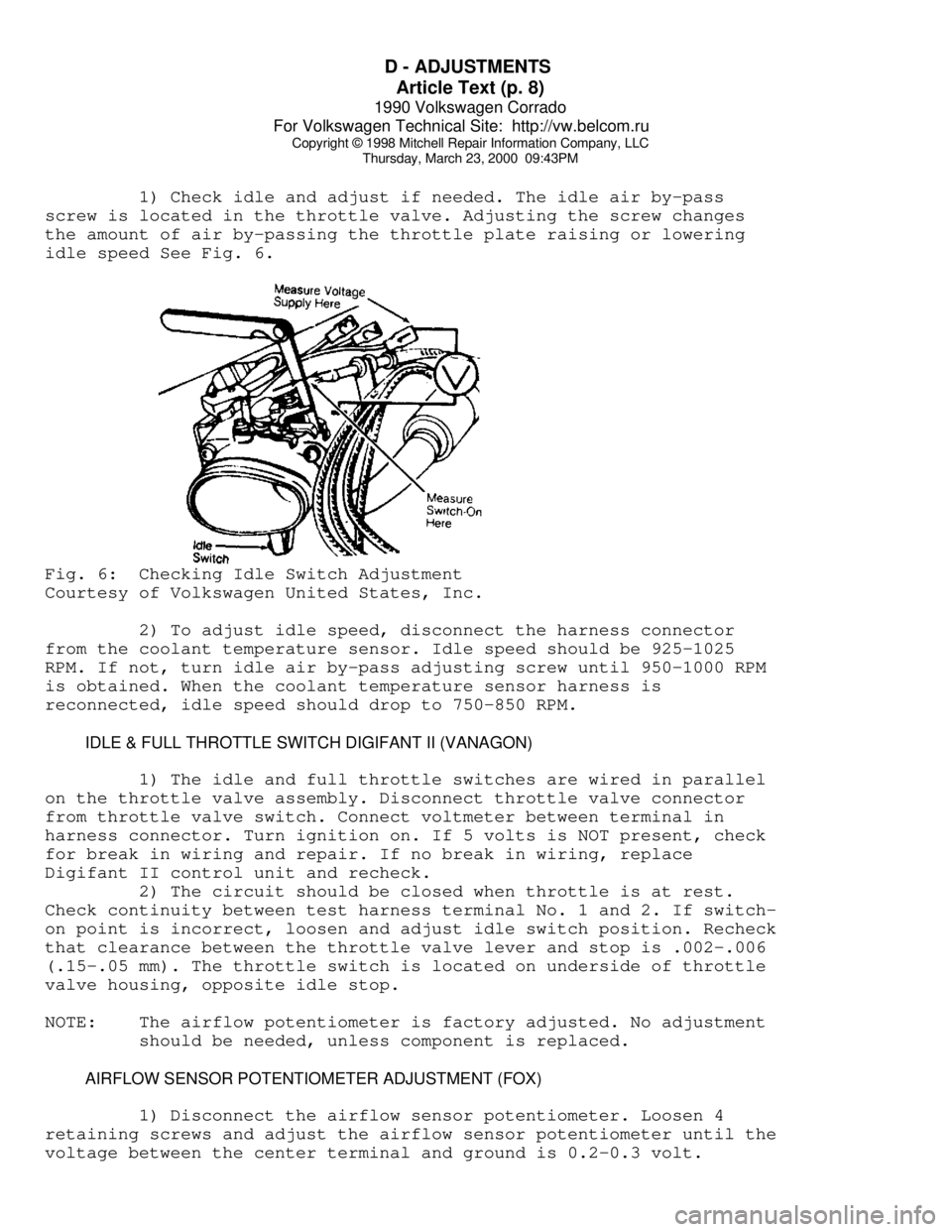
D - ADJUSTMENTS
Article Text (p. 8)
1990 Volkswagen Corrado
For Volkswagen Technical Site: http://vw.belcom.ru
Copyright © 1998 Mitchell Repair Information Company, LLC
Thursday, March 23, 2000 09:43PM
1) Check idle and adjust if needed. The idle air by-pass
screw is located in the throttle valve. Adjusting the screw changes
the amount of air by-passing the throttle plate raising or lowering
idle speed See Fig. 6.Fig. 6: Checking Idle Switch Adjustment
Courtesy of Volkswagen United States, Inc.
2) To adjust idle speed, disconnect the harness connector
from the coolant temperature sensor. Idle speed should be 925-1025
RPM. If not, turn idle air by-pass adjusting screw until 950-1000 RPM
is obtained. When the coolant temperature sensor harness is
reconnected, idle speed should drop to 750-850 RPM.
IDLE & FULL THROTTLE SWITCH DIGIFANT II (VANAGON)
1) The idle and full throttle switches are wired in parallel
on the throttle valve assembly. Disconnect throttle valve connector
from throttle valve switch. Connect voltmeter between terminal in
harness connector. Turn ignition on. If 5 volts is NOT present, check
for break in wiring and repair. If no break in wiring, replace
Digifant II control unit and recheck.
2) The circuit should be closed when throttle is at rest.
Check continuity between test harness terminal No. 1 and 2. If switch-
on point is incorrect, loosen and adjust idle switch position. Recheck
that clearance between the throttle valve lever and stop is .002-.006
(.15-.05 mm). The throttle switch is located on underside of throttle
valve housing, opposite idle stop.
NOTE: The airflow potentiometer is factory adjusted. No adjustment
should be needed, unless component is replaced.
AIRFLOW SENSOR POTENTIOMETER ADJUSTMENT (FOX)
1) Disconnect the airflow sensor potentiometer. Loosen 4
retaining screws and adjust the airflow sensor potentiometer until the
voltage between the center terminal and ground is 0.2-0.3 volt.
Page 446 of 906
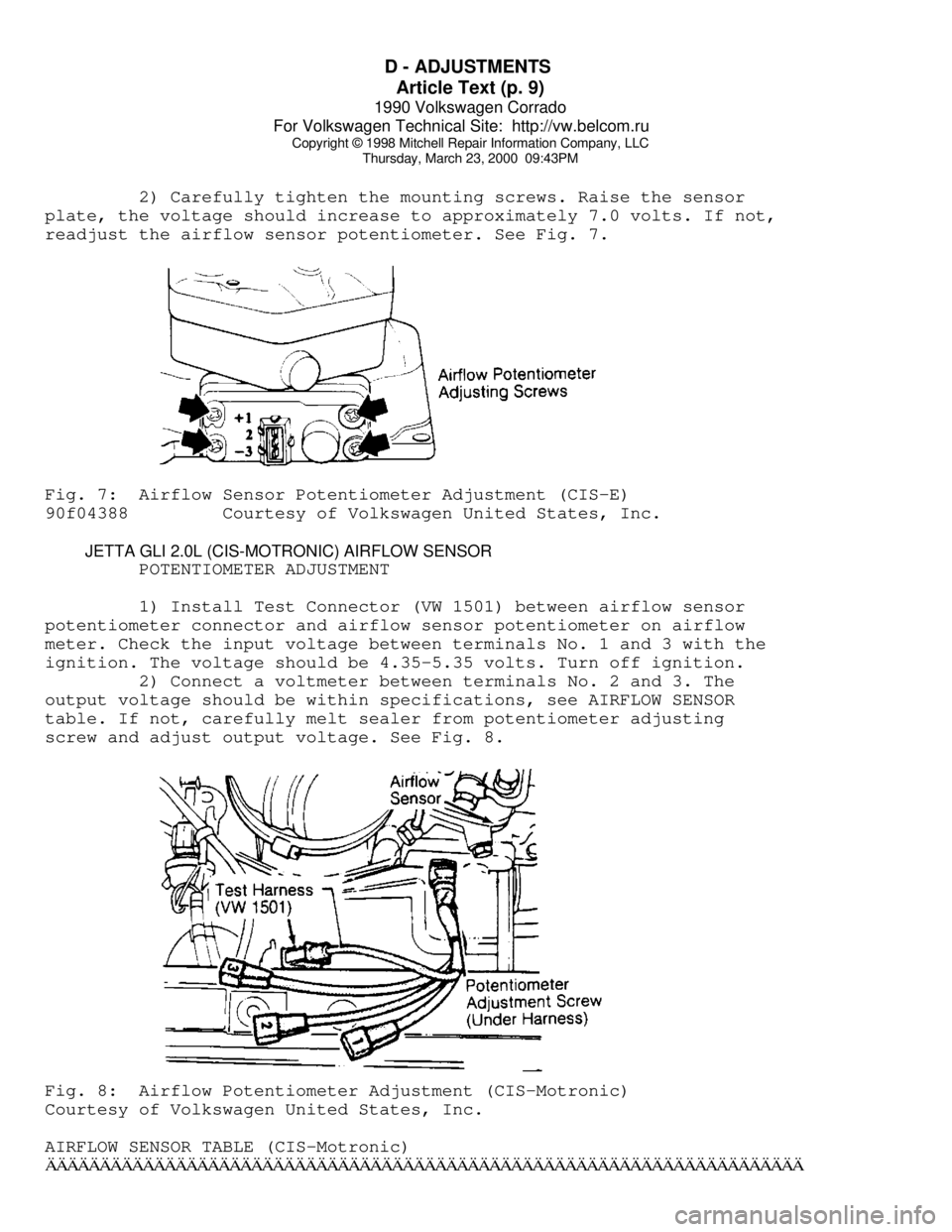
D - ADJUSTMENTS
Article Text (p. 9)
1990 Volkswagen Corrado
For Volkswagen Technical Site: http://vw.belcom.ru
Copyright © 1998 Mitchell Repair Information Company, LLC
Thursday, March 23, 2000 09:43PM
2) Carefully tighten the mounting screws. Raise the sensor
plate, the voltage should increase to approximately 7.0 volts. If not,
readjust the airflow sensor potentiometer. See Fig. 7.Fig. 7: Airflow Sensor Potentiometer Adjustment (CIS-E)
90f04388 Courtesy of Volkswagen United States, Inc.
JETTA GLI 2.0L (CIS-MOTRONIC) AIRFLOW SENSOR
POTENTIOMETER ADJUSTMENT
1) Install Test Connector (VW 1501) between airflow sensor
potentiometer connector and airflow sensor potentiometer on airflow
meter. Check the input voltage between terminals No. 1 and 3 with the
ignition. The voltage should be 4.35-5.35 volts. Turn off ignition.
2) Connect a voltmeter between terminals No. 2 and 3. The
output voltage should be within specifications, see AIRFLOW SENSOR
table. If not, carefully melt sealer from potentiometer adjusting
screw and adjust output voltage. See Fig. 8.Fig. 8: Airflow Potentiometer Adjustment (CIS-Motronic)
Courtesy of Volkswagen United States, Inc.
AIRFLOW SENSOR TABLE (CIS-Motronic)ÄÄÄÄÄÄÄÄÄÄÄÄÄÄÄÄÄÄÄÄÄÄÄÄÄÄÄÄÄÄÄÄÄÄÄÄÄÄÄÄÄÄÄÄÄÄÄÄÄÄÄÄÄÄÄÄÄÄÄÄÄÄÄÄÄÄÄÄÄÄ